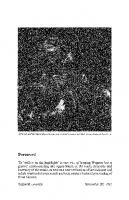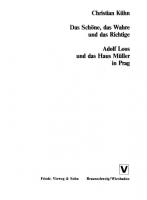Das Rheingold (The Rhinegold) 0714544361, 9780714544366
English National Opera Guides are ideal companions to the opera. They provide stimulating introductory articles together
158 13 18MB
English Pages 98 [99] Year 2011
The Beginnings of 'The Ring'
'The Rhinegold' – The Music
The Language and Sources of 'The Ring'
Thematic Guide
The Rhinegold
Scene One
Scene Two
Scene Three
Scene Four
Contributors
Discography
Bibliography
Recommend Papers

- Author / Uploaded
- Richard Wagner
File loading please wait...
Citation preview
Opera Guides
Alberich and the three Rhinemaidens at Covent Garden in 1964 (photo: Donald Southern)
Foreword To 'wallow in the highlights' is one way of hearing Wagner; but a greater understanding and appreciation of the form, structure and harmony of the music, as well as a true realisation of the intimate and subtle relation between music and text, can be obtained by a reading of these Guides. Reginald Goodall
November 20, 1985
Das Rheingold (The Rhinegold) Richard Wagner
Opera Guides Series Editor Nicholas John
OP OVERTURE
Overture Publishing an imprint of oneworld classics
London House 243-253 Lower Mortlake Road Richmond Surrey TW9 2LL United Kingdom This Opera Guide first published by John Calder (Publishers) Ltd in 1985 This new edition of Das Rheingold Opera Guide first published by Overture Publishing, an imprint of Oneworld Classics Ltd, in 2011 Articles © the authors © Oneworld Classics Ltd, 2011 English translation of the Das Rheingold libretto © Andrew Porter, 1985 isbn:
978-0-7145-4436-6
All the pictures in this volume are reprinted with permission or presumed to be in the public domain. Every effort has been made to ascertain and acknowledge their copyright status, but should there have been any unwitting oversight on our part, we would be happy to rectify the error in subsequent printings. All rights reserved. No part of this publication may be reproduced, stored in or introduced into a retrieval system, or transmitted, in any form or by any means (electronic, mechanical, photocopying, recording or otherwise), without the prior written permission of the publisher. This book is sold subject to the condition that it shall not be resold, lent, hired out or otherwise circulated without the express prior consent of the publisher. Printed in the United Kingdom
Contents
List of Illustrations
vi
The Beginning of 'The Ring' John Death ridge
7
'The Rhinegold' - The Mmlic Rog~;,>r North
15
Language and Sources of 'The Ring' Stewart Spencer
31
Thematic Guide Lionel Friend
39
'Das Rheingold' poem by R£chard Wagner 'The Rhinegold' English translation by Andrew Porter
43
Scene One
45
Scene Two
54
Scene Three
68
Scene Four
77
Contributors
92
Discography Cathy Peterson
94
Bibliography
96
List of Illustrations
Cover design: Anita Boyd Frontispiece: Alberich and the Rhinemaidens, Covent Garden, 1964 (photo: Donald Southern) Friedrichs, Breuer, Elmblad, Weed and Wachter, Bayreuth, 1897 (Royal Opera House Archives) p. 12 Eva Turner as Frda in 1924 (Royal Opera House Archives) p. 13 Leif Roar (Wotan) and Wolf Hirte (Alberich), Munich, 1975 (photo: Sabine Toepfter) p. 14 A scene from Tony Palmer's film Wagner (1982) and a contemporary drawing. The Rhinemaidens at Bayreuth, 1984 (photo: Fcstspielleitung Bayreuth) Alberich aud the Rhinemaidens at Bayreuth, 1980 (photo: Festspielleitung Bayreuth) James Morris (Wotan), San Francisco, 1985 (photo: William Acheson) p. 19 Robert Tear (Loge) and Yv:moe Minton (Fricka), Covent Garden, 1980 p. 20 (photo: Reg Wilson) George Shirley (Loge) and Donald Mcintyre (Wotan) at Covent Garden p. 21 (photo: Donald Southern) The journey down to Nibdheim at the Deuand nPrtr..•nn'H'1C'I>~ in a week the theatre be pulled down and the A few months after to in a letter dated
ofthenew again like ""·".r'""'ri some sketches for it survive. In another letter to Uhlig between October 6 and 1 announced this time that he had 'big ideas' about Siegfried: 't.hree dramas with an introduction in three acts'. He then wrote prose sketches for Der Raub (The Rhinegofd) and und Bestrafung and Sieg!inde: the Punishment and completed the ,.,_,,,_,,u~ what becan1e The and The in the following year. Strictly
9
'The Rhinegold' at Bayreuth in 1897: (left) Friedrichs and Breuer as Alberich and Mime and (right) Elmblad as Fafner, Weed as Freia and Ernst Wachter as Fasolt (Royal Opera House Archives)
speaking, Wagner was not creating anything new since he was simply expanding, step by step, the concept outlined in 1848 in Die Nibelungensage (Myth us). But in technique and emphasis, not to mention social function, the project was changing rapidly. What had begun as a 'grand heroic opera' turned into two 'dramas' and was becoming a trilogy with introduction that was eventually given the generic title 'Stage Festival Play'. Technically speaking, certain narrative elements in Siegfried's Death and The Young Siegfried were now redundant. Parts of the story that were simply related by characters on stage in these two works had themselves become part of the action in The Rhinegold and The Valkyrie. The significance of this in terms of Wagner's ideas about leitmotif has been the subject of much ingenious, though unprovable, speculation since sketches documenting the musical beginnings of The Ring are surprisingly scarce. 1 What is certain is that the fine tuning of the entire project involved not only the redistribution ofits narrative structure, but also a redressing of dramatic balance due to two significant additions to the beginning and the end of the cycle. On November 18, 1852, Wagner wrote to Uhlig: 'At themomentl am working on The Young Siegfried and should soon be finished with it Then I have to start on Siegfried's Death -that's going to take longer; two scenes have to be completely rewritten (the See e.g. Carl Dahlhaus, 'Zur Geschichte der Leitmotivtechnik bei Wagner' Das Drama Richard Wagners als musikalisches Kunstwerk, Regensburg 1970, p. 34£ According to Dahlhaus, the mythical elements in the Ring concept had a paradoxical musical significance. On the one hand, the mere narrative exposition of the myth in Siegfrieds Tod provided a barrier for the leitmotivic technique which, according to Wagner's treatise Opera and Drama (1850-51), was the musical means ofactualising 1
the complex world of myth in scenic terms. On the other hand, the recapitulation of the myth in the enlarged conception of The Ring became the reason for rich motivic expansion which intensifies as the work proceeds. What had originally impeded Wagner's musical imagination thus came to stimulate some ofhis most powerful music.
10
Norns' scene and Briinnhilde's scene with the Valkyries [Waltraute in the final and above all the ending.'
*
In view of the period in which The Ring 'Nas first conceived, it is hardly surprising that the first version ofits ending contained in the 1848 draft Die Nibelungensage is me









